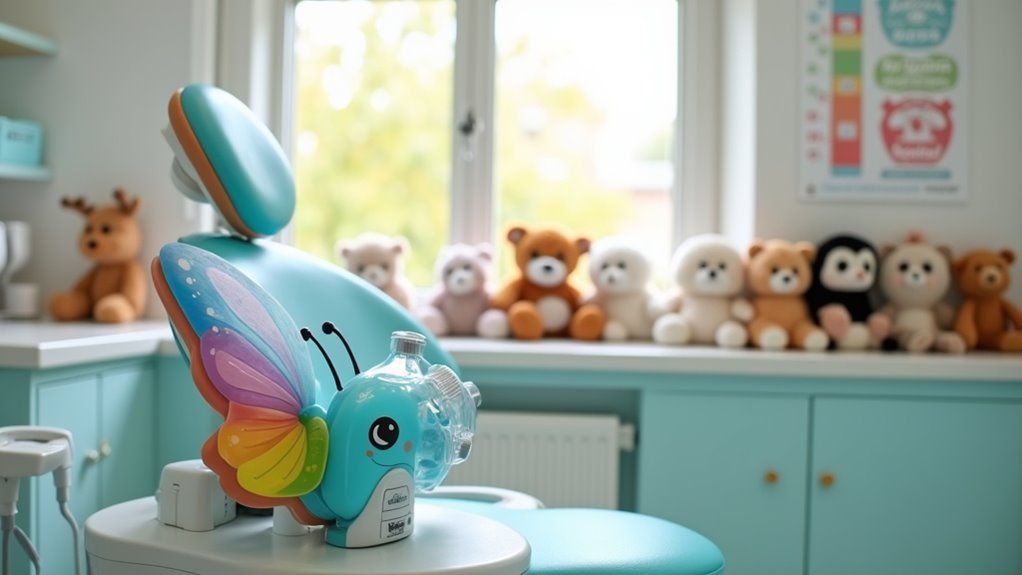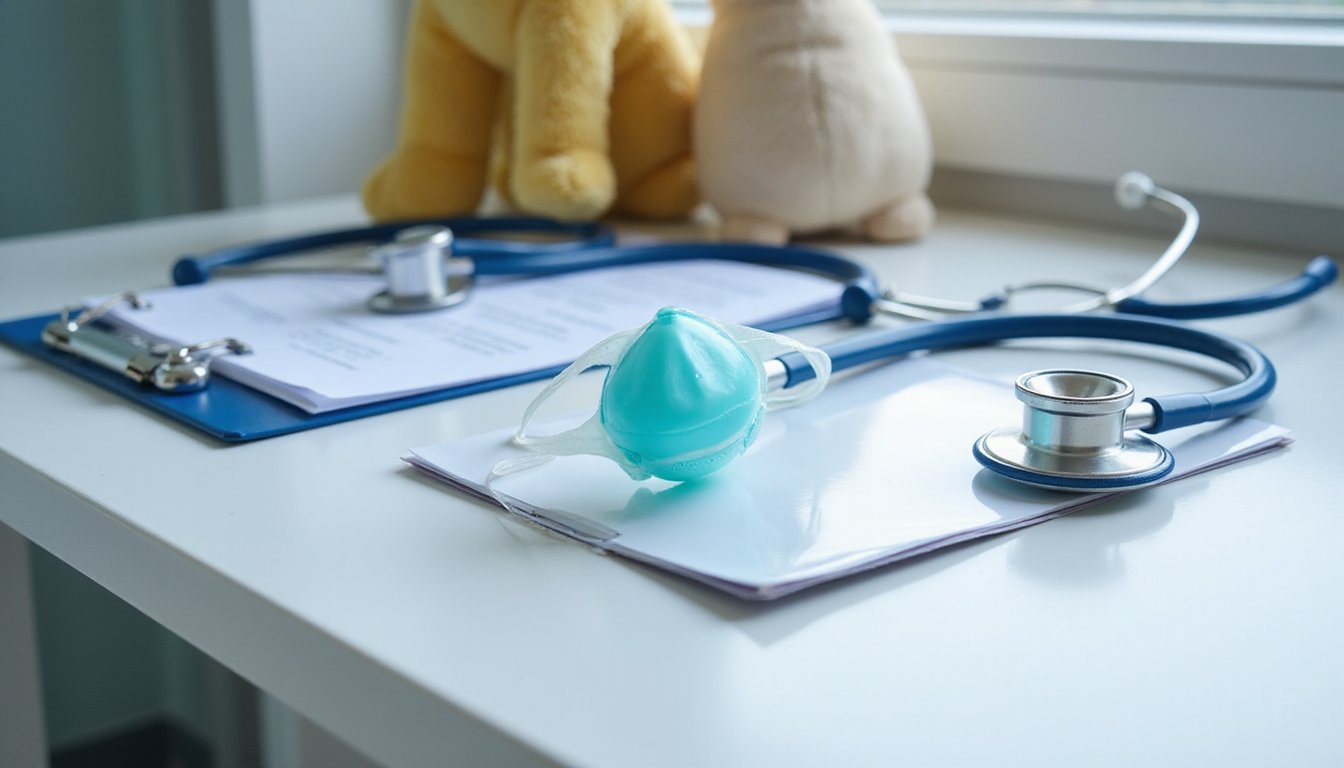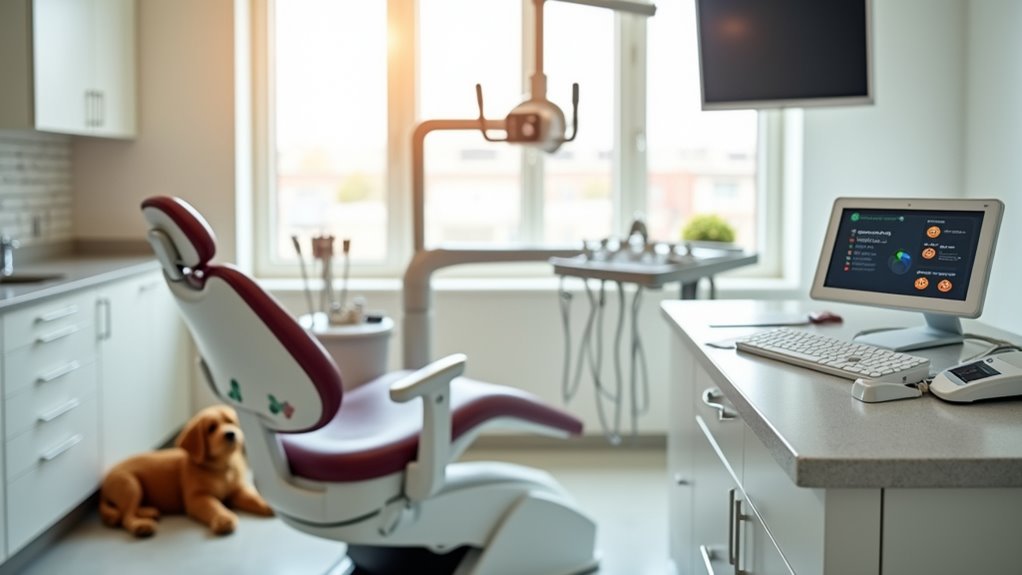Nitrous oxide sedation can be safely administered to your child between ages 4-18, with ideal outcomes typically seen in ages 6-9. Your child must demonstrate consistent nasal breathing, follow basic instructions, and tolerate mask placement. Medical screening includes respiratory function, vitamin B12 levels, and psychiatric history evaluation. While complications are rare under professional supervision, your child’s developmental preparedness and anxiety levels will determine treatment success. Further assessment factors guarantee optimal safety and effectiveness.
Understanding Age-Based Safety Guidelines

Every pediatric dental patient requires individualized evaluation when considering nitrous oxide sedation, with maturity serving as a critical baseline factor in safety protocols. You’ll need to assess your child’s physical development, particularly their nasal passages and respiratory function, as these directly impact the effectiveness of pain management during procedures. During treatment, the carefully controlled mixture of nitrous oxide and oxygen is delivered through a small nasal mask. The procedure is extremely safe and complications are very rare when administered properly. The calming effects begin almost immediately when your child starts breathing through the mask.
Your child’s emotional impact and ability to follow instructions greatly influence treatment success. The AAPD guidelines emphasize that dosage must align with your child’s weight and developmental stage, requiring careful calibration of nitrous oxide concentrations between 20-70%. You’ll work with dental professionals trained in pediatric sedation who’ll evaluate your child’s medical history, anxiety levels, and treatment complexity. They’ll also determine if alternative behavioral guidance methods might better serve your child’s needs before proceeding with nitrous oxide administration.
Evaluating Your Child’s Developmental Readiness
Determining your child’s readiness for nitrous oxide sedation hinges on multiple developmental markers that influence treatment success. Your child must demonstrate consistent nasal breathing ability and maintain head stability during procedures. They’ll need to follow basic instructions and tolerate the nasal mask placement. The mild sedation method helps children stay relaxed without falling asleep during dental work. Having your child practice with a disposable nasal hood at home before the procedure can help them feel more comfortable during treatment.
Parental involvement through clear pre-procedure explanations drastically impacts your child’s cooperation levels. Consider your child’s existing anxiety management strategies, as these can complement nitrous oxide’s effects. Evaluate their dental rapport, as mistrust may reduce sedation effectiveness. Your child’s ability to handle brief parental separation and maintain composure during minor discomfort serves as a key indicator of readiness. Likewise, assess their physical stamina for remaining seated during treatment, as this directly affects procedural safety and efficacy.
Key Medical Considerations for Young Patients

Multiple critical medical factors must be evaluated before administering nitrous oxide to young patients. Your child’s respiratory system maturity and dental development considerations directly impact treatment safety. Providers must assess vitamin B12 levels, psychiatric history, and potential medication interactions, particularly with anxiolytics or SSRIs. Trained professionals carefully monitor patients throughout the entire procedure to ensure safety. Based on the research data, patients aged 6 to 9 years showed optimal outcomes with nitrous oxide sedation.
| Medical Factor | Risk Assessment | Required Action |
|---|---|---|
| Mental Health | Psychosis risk | Screen for disorders |
| Respiratory Function | Breathing capacity | Evaluate lung maturity |
| B12 Status | Deficiency impact | Check vitamin levels |
| Drug Interactions | Sedation effects | Review medications |
| Development Stage | Developmental appropriateness | Assess communication ability |
Your child’s provider will maintain strict oxygen-to-nitrous oxide ratios (≤30%) while monitoring crucial signs continuously. For patients under young age, alternative anxiety management strategies are recommended due to immature respiratory systems and limited communication abilities.
Anxiety Management Benefits at Different Ages
As children progress through different developmental stages, nitrous oxide’s anxiety-management benefits demonstrate generational effectiveness patterns. You’ll find that children aged 2+ show measurable reductions in anxiety when receiving this sedation method, particularly during procedures like IANBs. Emotional health considerations become increasingly manageable as the treatment allows for adjustable sedation levels while maintaining consciousness. Double-blinded trials have consistently validated the efficacy of nitrous oxide sedation in pediatric patients.
Family support dynamics improve greatly when parents observe their child’s reduced distress levels during dental procedures. You can expect validated pain scales, such as FLACC and Facial Image, to show decreased discomfort scores across age groups. The short-term nature of the sedation (approximately 5 minutes) certifies that children can quickly return to their daily activities, making it particularly suitable for school-age patients requiring multiple dental visits.
Pre-Treatment Assessment Protocol

Before administering nitrous oxide to pediatric patients, practitioners must complete a thorough pre-treatment assessment protocol that evaluates five key domains. You’ll need to guarantee a comprehensive airway evaluation and appropriate mask fit for children of the appropriate developmental stage who can demonstrate self-holding capabilities. The assessment includes medical history review, focusing on respiratory conditions and ASA classification. Dentist behaviors influence the success of nitrous oxide administration in reducing child anxiety.
| Assessment Domain | Key Components | Critical Indicators |
|---|---|---|
| Physical Development | Orofacial coordination | Mask sealing ability |
| Medical Status | Respiratory health | Asthma severity/control |
| Emergency Readiness | Rescue medications | Albuterol availability |
| Behavioral Assessment | Anxiety levels | Instruction compliance |
Your evaluation must document developmental milestones, verify fasting status, and ensure emergency protocols are in place. Pay special attention to anxiety severity through validated tools and assess parent-child dynamics that could impact treatment success.
Monitoring and Safety During Administration
Proper monitoring and safety protocols serve as the foundation for successful nitrous oxide administration in pediatric patients. You’ll need to maintain continuous physiological monitoring of breathing rate, oxygen saturation, and heart rate while using standardized scales like FLACC to assess pain and anxiety levels. The rapid onset time of nitrous oxide allows dental teams to quickly assess its effectiveness and make necessary adjustments. Since it is non-allergenic, nitrous oxide is considered one of the safest sedation options for children. Pain and anxiety can be effectively managed using nitrous oxide, according to the American Dental Association. Staffing requirements mandate that all personnel hold pediatric sedation certification and remain prepared for potential complications.
During administration, you must guarantee proper mask fit with nose-only delivery, maintain oxygen concentrations ≥20%, and utilize controlled titration of nitrous oxide (30-70%). Emergency preparedness protocols require accessible resuscitation equipment and immediate response plans for adverse reactions. You’ll need to document all procedures thoroughly, including flow rates and patient responses, while employing active scavenging systems to protect both patients and staff from excess N₂O exposure.
Alternative Options for Very Young Children
Very young children require specialized approaches beyond nitrous oxide sedation due to youth-specific contraindications and developmental limitations. If your child is under two years old, you’ll need to explore alternative comfort techniques, as they can’t effectively distinguish between sedation sensations. These may include topical anesthetics, guided imagery, or specialized sensitivity protocols customized to their developmental stage. Since nitrous oxide effects dissipate quickly, older children can typically return home right after treatment. While nitrous oxide offers good quality analgesia, its use requires careful consideration in vulnerable populations.
For children with complex medical conditions or psychiatric disorders, you’ll find hospital-based options more suitable. Your provider might recommend desensitization therapy, interactive communication strategies, or segmented treatment sessions. You can also utilize sensory-friendly environments and parental presence techniques to reduce anxiety. In cases where traditional methods prove insufficient, your healthcare team may suggest referrals to pediatric specialists or consider general anesthesia in controlled settings.
Signs of Nitrous Oxide Readiness
Your child’s readiness for nitrous oxide sedation depends on clear behavioral markers, including their ability to follow basic instructions and remain cooperative during dental visits. A pivotal indicator is your child’s comfort level with the nasal mask, demonstrated through their willingness to breathe normally while wearing it and maintain appropriate positioning during treatment. You’ll also want to assess your child’s anxiety management capabilities, such as their ability to respond to reassurance and distinguish between procedural discomfort and fear, as these skills directly impact the sedation’s effectiveness. Since nitrous oxide works by acting on nerves to create calmness, children must demonstrate basic self-regulation abilities before treatment.
Behavioral Maturity Indicators
Five key behavioral maturity indicators help determine a child’s readiness for nitrous oxide sedation in the dental setting. Your child must demonstrate environmental familiarity by exploring the dental space without panic and tolerating the operatory environment. They’ll need to follow basic instructions and maintain proper positioning during administration, even when facing behavioral maturity challenges.
Sensory adjustment strategies become essential as your child develops comfort with the hood placement and gas sensations. They must exhibit emotional control through relaxation techniques and clear communication of discomfort. Ultimately, your child should show adequate post-procedure adaptation, including the ability to recover from sedation effects and resume normal activities. These indicators collectively guarantee safe and effective nitrous oxide administration while minimizing anxiety-related complications during dental procedures.
Mask Comfort Assessment
Successful mask comfort assessment relies on multiple clinical indicators that determine a child’s readiness for nitrous oxide sedation. You’ll need to evaluate mask fit evaluation criteria, including proper seal formation and adaptability to facial structures. Modern mask design features, such as the Porter Silhouette’s flexible composition, boost patient acceptance and minimize resistance.
| Assessment Parameter | Clinical Significance |
|---|---|
| Nasal Bridge Fit | Prevents gas leakage and guarantees ideal delivery |
| Facial Structure Match | Determines appropriate mask size selection |
| Breathing Pattern | Confirms effective gas flow and ventilation |
Monitor your patient’s physiological responses during mask placement trials. Look for signs of relaxed breathing patterns and calm demeanor. Pre-appointment mask exploration considerably reduces anxiety, while continuous feedback helps maintain prime positioning throughout the procedure.
Anxiety Management Capability
Beyond proper mask fit, determining a child’s readiness for nitrous oxide sedation requires careful evaluation of anxiety management indicators. You’ll find that 86% of children demonstrate altered consciousness during administration, confirming its effectiveness for anxiety reduction. Ideal dosage increments start at concentrations below 50%, with careful titration based on individual responses.
Patient monitoring protocols should focus on psychomotor performance, where most children maintain stable skills with minimal impairment (≤5 errors under sedation). You’ll need to assess the child’s baseline anxiety levels and consider developmental stage-related motor skill maturity when determining readiness. For best results, combine nitrous oxide with behavioral guidance techniques and age-appropriate communication about sedation sensations. Remember, it’s most effective for mild to moderate anxiety cases, requiring alternative approaches for severe presentations.
Parent’s Guide to Informed Decision Making
When considering nitrous oxide for your child’s dental anxiety, you’ll need to evaluate suitability, with children under 2 years typically being ineligible due to comprehension limitations. Your dental provider will conduct a thorough risk-benefit analysis, weighing the documented anxiety-reduction benefits against potential side effects like temporary dizziness or nausea. The treatment planning process includes pre-procedure medical screening, assessment of your child’s ability to cooperate with mask administration, and development of a post-procedure recovery protocol.
Age-Based Risk Assessment
Parents considering nitrous oxide sedation for their children must understand that maturity-related risk assessment depends primarily on developmental readiness rather than the numerical period. Your child’s ability to follow breathing instructions and cooperate with mask placement serves as a pivotal patient-specific risk factors that influence safety and effectiveness.
While there’s no universal minimum age requirement, your healthcare provider will evaluate your child’s communication capacity and tolerance for the nasal mask. Dosage adjustment guidelines factor in your child’s weight, procedure duration, and individual anxiety levels. For shorter, straightforward procedures, nitrous oxide typically proves most beneficial, with recovery occurring within 5-10 minutes.
Your provider will assess pre-existing conditions, such as respiratory issues or vitamin B12 deficiency, to guarantee safe administration and minimize potential complications.
Benefits vs. Safety Concerns
Understanding the balance between nitrous oxide’s benefits and risks requires careful consideration of patient-specific factors before proceeding with sedation. While dosage adjustments enable precise anxiety control, you’ll need to weigh these risk-benefit tradeoffs against your child’s specific health conditions.
| Benefit | Safety Concern |
|---|---|
| Quick anxiety reduction | Potential nerve damage with prolonged use |
| Controlled sedation levels | Risk of over-sedation requiring monitoring |
| Minimal recovery time | Short-term dizziness or nausea |
| Non-invasive administration | Contraindications with respiratory issues |
You’ll find nitrous oxide offers efficient anxiety management through customizable delivery, but safety protocols remain crucial. Continuous vital sign monitoring and proper ventilation help minimize risks, while immediate side-effect reporting guarantees prompt intervention if needed. For ideal outcomes, you must discuss your child’s complete health history and consider alternative sedation options when contraindications exist.
Treatment Planning Considerations
Several critical factors shape treatment planning decisions for nitrous oxide sedation in pediatric patients. Patient selection criteria must account for your child’s age, typically starting at 3 years, and their developmental readiness to cooperate with nasal mask administration. Your child’s medical history, particularly regarding asthma and respiratory conditions, will greatly influence treatment planning.
Anesthesia team coordination involves thorough pre-screening, including medication reviews and allergy assessments. You’ll need to disclose your child’s current health status, as recent illnesses may require rescheduling. The team will evaluate alternative sedation options if nitrous oxide isn’t suitable, such as oral or IV sedation. They’ll also determine whether local anesthetic supplementation is necessary based on the specific procedure and your child’s pain tolerance. Documentation of all planning decisions guarantees optimal safety protocols during treatment.
Post-Treatment Care and Recovery Tips
Managing post-treatment care after nitrous oxide sedation requires minimal intervention due to the substance’s rapid clearance from the body. You’ll notice your child typically recovers within five minutes post-mask removal, allowing for immediate return to normal activities.
Implement calming techniques and maintain a reassuring presence while monitoring for any temporary anxiety recurrence or behavioral changes. Post-procedure expectations should include brief observation for potential side effects such as hallucinations or unusual euphoria. If these occur, document them and contact your dentist if severe reactions develop.
For ideal recovery, avoid strenuous activities briefly and offer light snacks if needed. Continue implementing anxiety management strategies through positive reinforcement and normalized dental experiences. For special health cases or patients with psychiatric disorders, follow your provider’s specific post-sedation protocols and schedule recommended follow-up visits.
Frequently Asked Questions
Can Nitrous Oxide Affect My Child’s Memory or Cognitive Development Long-Term?
While the possible long-term effects of nitrous oxide on memory and cognitive development haven’t been conclusively proven in humans, you should know that research is ongoing. Current clinical evidence doesn’t show direct links to neurodevelopmental impacts when used alone. However, animal studies suggest concerns when it’s combined with other anesthetics. Given the FDA’s safety alerts and limited longitudinal data, you’ll want to discuss specific risks with your healthcare provider.
How Long Should We Wait Between Multiple Dental Appointments Using Nitrous Oxide?
You don’t need to wait between dental appointments using nitrous oxide, as standard dosage guidelines confirm it’s cleared from the body within minutes after switching to pure oxygen. Safety considerations show no accumulation between sessions, and there’s no evidence supporting mandatory waiting periods. You can schedule back-to-back appointments if needed, as the gas is rapidly eliminated without residual effects. Professional dental organizations haven’t established required intervals between treatments.
Does Nitrous Oxide Interact With Common ADHD or Anxiety Medications?
You’ll need to inform your healthcare provider about all medications you’re taking, as nitrous oxide can interact with different drugs. It particularly affects CNS depressants like benzodiazepines, potentially amplifying sedative effects. While specific medication interactions with ADHD medications aren’t extensively documented, dosage guidelines may need adjustment based on your current prescriptions. There’s limited direct evidence regarding SSRI interactions, but medical supervision is critical to guarantee safe administration and prevent adverse effects.
Can Siblings Be Present During Nitrous Oxide Administration to Comfort Anxious Children?
While sibling presence during nitrous oxide administration isn’t extensively documented in clinical research, you’ll find that dental practices typically evaluate this on a case-by-case basis. For dental anxiety management, siblings may provide comfort if they’re mature and calm. However, you should note that most practices prefer limiting treatment room occupancy to parents/guardians only, as siblings could potentially disrupt the sedation process or create infection control concerns. Always check your dentist’s specific protocols.
Will Nitrous Oxide Exposure Affect Future Responses to Anesthesia or Sedation?
You won’t need to worry about potential anesthesia interactions from nitrous oxide exposure. Current clinical evidence doesn’t show any documented cases of altered responses to future sedation or anesthesia. While research limitations exist regarding long-term developmental effects, studies haven’t found increased tolerance or resistance to subsequent sedation procedures. However, if you’re receiving repeated treatments, your healthcare provider should carefully monitor your individual responses and maintain detailed records.









